

Rocket comparison. CRS-8 Dragon - SpaceX lands its rocket on a floating ship for the first time. SpaceX successfully lands its rocket on a floating drone ship for the first time. SpaceX has finally landed its Falcon 9 rocket on a drone ship at sea, after launching the vehicle into space this afternoon.

It's the first time the company has been able to pull off an ocean landing, after four previous attempts ended in failure. Today's success is a crucial milestone for SpaceX, as it shows the company can land its rockets both on solid ground and at sea. Andromeda Galaxy. Solar System 2.0 - the helical model. Earth Spin Animation. Earth's motion around the Sun, not as simple as I thought. Ordnance Survey releases digital map of Mars surface. Image copyright Ordnance Survey.

Skylab The First 40 Days 1970s NASA Space Station Video Documentary. Viewing Distant Galaxies - On Your Computer. If you’re interested in astronomy then here is some exciting news.

You can now view distant galaxies, in good definition, from your own computer. Peering down a telescope for a faint image is still fun, but new software offers some spectacular images. Developed by astrophysicists, an “expansion pack” that provides a virtual tour of the universe. From a Million Miles: The Moon Crossing the Face of Earth. Extra-Tropical Alex Speeding Through North Atlantic Tropical Storm Alex quickly acquired extra-tropical characteristics late on Jan. 15 as it sped northward toward Greenland in the North Atlantic Ocean.
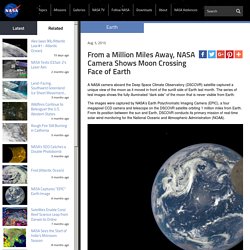
A GOES-East satellite image on Jan. 16 showed the elongated system south of Greenland. Tropical Storm Alex became extra-tropical by Jan. 15 at 2100 UTC (4 p.m. EST). Moon Phases 2016, Northern Hemisphere - 4K. HOW IT WORKS: The International Space Station (1080p, 60fps) Recap of Falcon 9 launch and landing. Distance between the moon and earth. Heliocentrism VS Geocentrism. Pluto Close Up. Simulation of 2 planets colliding. Earth Polychromatic Camera. Pluto crop color enhanced release - Warning 70MB image. Pluto. NASA Mars Trek. NASA Camera Shows Moon Crossing Face of Earth. Aurora Borealis seen from ISS. Pluto. Why bother exploring the Solar System? - BBC News. During a week of revelations about the strange worlds at the edge of the solar system, I repeatedly heard a question that often comes up about space: "why bother?
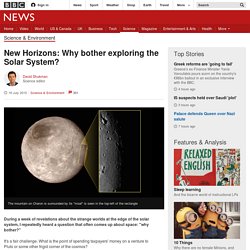
" It's a fair challenge. What is the point of spending taxpayers' money on a venture to Pluto or some other frigid corner of the cosmos? Or having some of our greatest brains devoted to studying alien rock and ice when they could be working on problems much closer to home? And nobody should duck the question. So here goes: should journalists like me, along with camera crews, even cover an event like the New Horizons mission? This was first brought home to me during the European Space Agency's dramatic touchdown on a comet last November. Philae comet lander wakes up - BBC News. The European Space Agency (Esa) says its comet lander, Philae, has woken up and contacted Earth.

Philae was dropped on to the surface of Comet 67P by its mothership, Rosetta, last November. It worked for 60 hours before going to sleep when its solar-powered battery ran flat. Sizes of the planets relative to the moon as seen from Earth. Moon shadow during sun eclipse. How to FLY A SPACESHIP to the SPACE STATION - Smarter Every Day 131. Volume of Water in Europa and Earth.
Hubble's Amazing Universe Full HD 1080p, Amazing Documentary. Planet's axis in the Solar System. Spacex Falcon Heavy - Flight Animation. Comparison optical telescope primary mirrors. 5,200 Days in Space. When humans move to space, we are the aliens, the extraterrestrials.
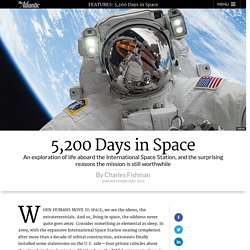
And so, living in space, the oddness never quite goes away. Consider something as elemental as sleep. Nasa just emailed a wrench to space. When International Space Station commander Barry Wilmore needed a wrench, Nasa knew just what to do.
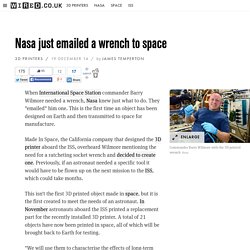
They "emailed" him one. This is the first time an object has been designed on Earth and then transmitted to space for manufacture. Made In Space, the California company that designed the 3D printer aboard the ISS, overheard Wilmore mentioning the need for a ratcheting socket wrench and decided to create one. Previously, if an astronaut needed a specific tool it would have to be flown up on the next mission to the ISS, which could take months. BBC iWonder - What makes space travel so dangerous? Code and Life: Philae: The Biggest Jump Ever. So, Philae bounced twice before coming to a halt. 'Bounce' does not quite describe it correctly.
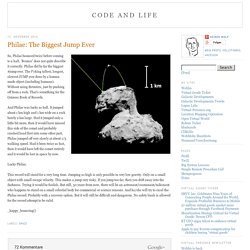
Philae did by far the biggest #jump ever. The f*cking tallest, longest, slowest JUMP ever done by a human made object (including humans). Without using thrusters, just by pushing off from a rock. That's something for the Guiness Book of Records. And Philae was lucky as hell. Lucky Philae. Rethinking the origins of the universe. Singled out: Laura Mersini-Houghton has mathematically proven that quantum effects are strong enough to stop the formation of black holes, work that opens up a new round of discussions and debates about the origins of the universe.
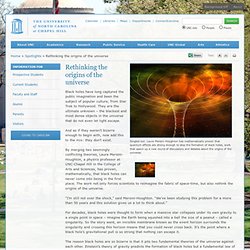
Black holes have long captured the public imagination and been the subject of popular culture, from Star Trek to Hollywood. Aeronautics e-Book Archive. NASA Confirms the "Impossible" - Propellant-free Microwave Thruster for Spacecraft Works! Designs for a device called a microwave thruster, which could power spacecraft without the need for propellant, have been proposed since 2006. While the engine follows the principles of relativity theory in converting electrical energy into force to produce thrust, it has been dismissed as impossible in practice since it defies the law of conservation of momentum. But a team from NASA has just successfully trialled their own version of the engine, which changes everything. Several years ago British scientist Roger Shawyer presented his EmDrive microwave thruster engine to the scientific community. It used microwaves bounced off reflectors in a sealed container to produce small amounts of force and thereby achieve propulsion via propellant-free thrust.
Its possibilities for long-distance spaceflight were extraordinary, but while it was groundbreaking there was one catch: it defied the law of conservation of momentum and was therefore deemed theoretically flawed. . + EmDrive. Sea plankton have been found on the International Space Station – but how did they get there? Sea plankton have been found on the outside of the International Space Station, a Russian news agency reports.
Itar-Tass says scientists on the space station, whose first component was launched into orbit in 1998, found the plankton – a source of food to many sea creatures – when taking samples from the windows (or “illuminators”). This, the agency writes, confirms “that some organisms can live on the surface of the International Space Station (ISS) for years amid factors of a space flight, such as zero gravity, temperature conditions and hard cosmic radiation. Several surveys proved that these organisms can even develop.” Stuff website reported that the plankton samples “were not carried there at launch, but are thought to have been blown over by air currents on Earth”.
Do We Live in the Matrix? They could create a plethora of pet universes, vastly outnumbering the real cosmos. This thought led philosopher Nick Bostrom at the University of Oxford to conclude in 2003 that it makes more sense to bet that we’re delusional silicon-based artificial intelligences in one of these many forgeries, rather than carbon-based organisms in the genuine universe. Since there seemed no way to tell the difference between the two possibilities, however, bookmakers did not have to lose sleep working out the precise odds.
Learning the Truth That changed in 2007 when John D. Barrow, professor of mathematical sciences at Cambridge University, suggested that an imperfect simulation of reality would contain detectable glitches. The helical model - our solar system is a vortex. The myth of NASA's expensive space pens. Study finds astronauts' hearts become more spherical in space. 29-Mar-2014 [ Print | E-mail ] Share [ Close Window ] Contact: Beth Casteelbcasteel@acc.org 202-375-6275American College of Cardiology New findings from a study of 12 astronauts show the heart becomes more spherical when exposed to long periods of microgravity in space, a change that could lead to cardiac problems, according to research to be presented at the American College of Cardiology's 63rd Annual Scientific Session. With implications for an eventual manned mission to Mars, the findings represent an important step toward understanding how a spaceflight of 18 months or more could affect astronauts' heart health.
"The heart doesn't work as hard in space, which can cause a loss of muscle mass," said James Thomas, M.D., Moore Chair of Cardiovascular Imaging and Lead Scientist for Ultrasound at NASA, and senior author of the study. Lift off. The Tyranny of the Rocket Equation. The Tyranny of the Rocket Equation By Expedition 30/31 Flight Engineer Don Pettit Tyranny is a human trait that we sometimes project onto Nature. This projection is a form of rationalization, perhaps a means to cope with matters that we cannot control. Apollo Staging. Curiosity Rover Makes Big Water Discovery in Mars Dirt, a 'Wow Moment' Peer Into Early Astronaut Spacesuits With These X-Ray Photographs. FYI: How Often Do Astronauts Do Laundry? Astronaut Chris Cassidy Shows Off Faulty Spacesuit (Part 1) Twelve Months in Two Minutes; Curiosity's First Year on Mars. Hammer vs Feather - Physics on the Moon: Galileo and Apollo 15.
The illusion of time : past, present and future all exist together. How powerful was the Apollo 11 computer? Single Camera (Hexacopter) Canadian astronaut Chris Hadfield to retire. 10 June 2013Last updated at 17:19 ET Chris Hadfield also met Canadian Prime Minister Stephen Harper on Monday. Mars pebbles prove water history. 31 May 2013 Last updated at 08:01 ET By Jonathan Amos Science correspondent, BBC News. Revealed: The Awesome Explanation for the Moon’s Extra Gravity.
In 1968, just a year before the historic Apollo 11 Moon landing , NASA scientists discovered something that could have sent astronauts Neil Armstrong , Buzz Aldrin and Michael Collins plunging to their deaths: an unexpected gravitational force—one so strong it caused the unmanned Lunar Orbiter spacecraft to violently shake up and down as it orbited Earth ’s neighbor.
International Space Station to boldly go with Linux over Windows. What if you were born in space? Sliced Meteorite. NASA-backed fusion engine could cut Mars trip down to 30 days. High performance access to file storage NASA, and plenty of private individuals, want to put mankind on Mars. Alpha Magnetic Spectrometer zeroes in on dark matter. 3 April 2013Last updated at 11:03 ET. The Known Universe by AMNH. NOVA by PBS. How Astronauts go to the bathroom. Riding the Booster with enhanced sound. Space Shuttle Launch: Viewed From an Airplane. Planck satellite: Maps detail Universe's ancient light. By Jonathan Amos Science correspondent, BBC News, Paris. The crab nebula. Apollo 11 Ultra Slow Motion 16mm HD launch. Apollo F-1 engines recovered from Atlantic ocean floor by Bezos Expeditions. Eclipse. A Super Solar Flare - Auroras over El Salvador. Elon Musk Just Showed Never-Before-Seen Video Of A Reusable Rocket Launch.
History of Flight, Aviation, Space Exploration. Tutulemma - Tracing the sun's path. Rosetta flight path from launch to landing on the comet. Where is Rosetta? Amazing Movie of Next Mars Rover HD. How to Get to Mars. Very Cool! HD. Three Generations of Rovers with Standing Engineers. How does NASA drive Mars rover Curiosity? Curiosity Mars Rover picture.